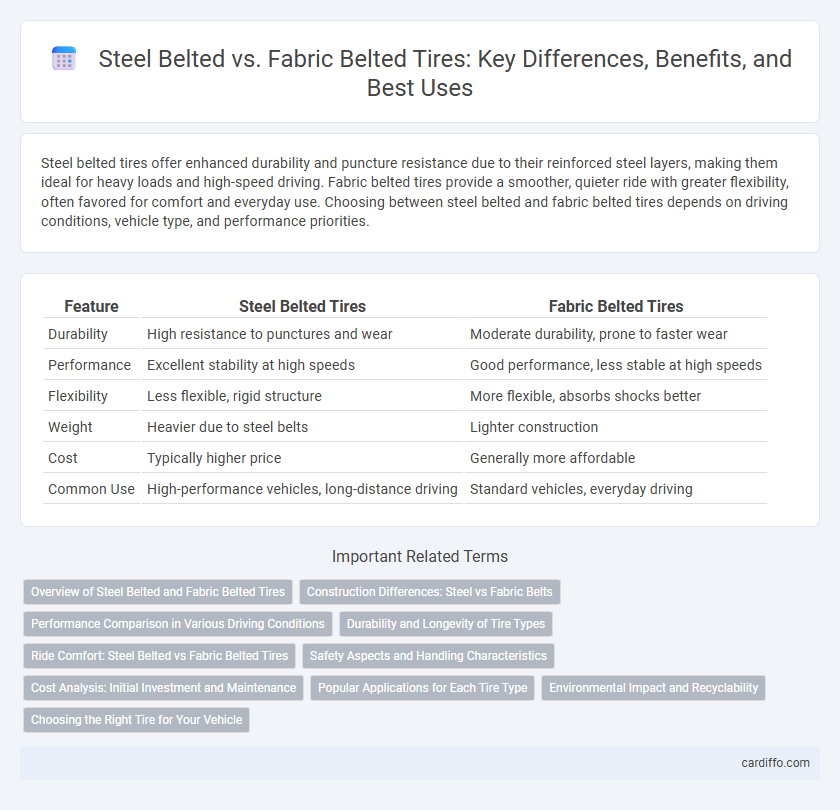Steel belted tires offer enhanced durability and puncture resistance due to their reinforced steel layers, making them ideal for heavy loads and high-speed driving. Fabric belted tires provide a smoother, quieter ride with greater flexibility, often favored for comfort and everyday use. Choosing between steel belted and fabric belted tires depends on driving conditions, vehicle type, and performance priorities.
Table of Comparison
| Feature | Steel Belted Tires | Fabric Belted Tires |
|---|---|---|
| Durability | High resistance to punctures and wear | Moderate durability, prone to faster wear |
| Performance | Excellent stability at high speeds | Good performance, less stable at high speeds |
| Flexibility | Less flexible, rigid structure | More flexible, absorbs shocks better |
| Weight | Heavier due to steel belts | Lighter construction |
| Cost | Typically higher price | Generally more affordable |
| Common Use | High-performance vehicles, long-distance driving | Standard vehicles, everyday driving |
Overview of Steel Belted and Fabric Belted Tires
Steel belted tires feature layers of steel wires beneath the tread, providing enhanced durability, improved puncture resistance, and better handling performance compared to fabric belted tires. Fabric belted tires use textile cords such as polyester or nylon, offering a smoother ride and greater flexibility but generally less strength and tread stability than steel belted options. The choice between steel belted and fabric belted tires impacts longevity, traction, and overall driving experience depending on vehicle type and road conditions.
Construction Differences: Steel vs Fabric Belts
Steel belted tires feature multiple layers of steel cords embedded beneath the tread, offering superior strength, durability, and puncture resistance compared to fabric belted tires. Fabric belted tires use layers of synthetic fibers such as polyester, nylon, or rayon, which provide flexibility and reduced weight but generally less rigidity and protection against impact. The construction difference impacts tire performance, with steel belts enhancing stability and tread life, while fabric belts contribute to a smoother ride and improved traction in specific conditions.
Performance Comparison in Various Driving Conditions
Steel belted tires offer superior durability and enhanced puncture resistance, making them ideal for high-speed performance and highway driving due to their strong steel cords that maintain tread integrity. Fabric belted tires provide a smoother, quieter ride with increased flexibility, excelling in comfort and traction on wet or rough surfaces but may wear faster under heavy loads or aggressive driving. Choosing between steel belted and fabric belted tires depends on the priority for long-term resilience versus immediate ride comfort and versatile traction in varied road conditions.
Durability and Longevity of Tire Types
Steel belted tires feature reinforced steel strips that significantly enhance durability and puncture resistance, resulting in extended tire longevity compared to fabric belted tires. Fabric belted tires rely on layers of textile material such as polyester or nylon, offering flexibility but generally less resistance to wear and impact. Consequently, steel belted tires maintain tread integrity longer and perform better in high-stress driving conditions, making them the preferred choice for long-lasting tire performance.
Ride Comfort: Steel Belted vs Fabric Belted Tires
Steel belted tires provide enhanced ride comfort by offering superior stability and reduced road noise due to their rigid steel belts, which maintain tire shape and distribute pressure evenly. Fabric belted tires, while generally softer and more flexible, may result in a less smooth ride as their construction can cause increased vibration and road feedback. Choosing between steel belted and fabric belted tires impacts overall driving comfort, with steel belts favored for stability and quietness, while fabric belts may offer a slightly softer, but less controlled, ride experience.
Safety Aspects and Handling Characteristics
Steel belted tires provide enhanced safety through superior puncture resistance and improved tread stability, reducing the risk of blowouts and enhancing overall road grip. Fabric belted tires, while generally lighter and more flexible, may offer less resistance to impact damage but provide smoother handling and better ride comfort. The choice between steel and fabric belts significantly impacts handling characteristics, with steel belts optimizing directional stability and cornering precision, crucial for high-speed and heavy-load conditions.
Cost Analysis: Initial Investment and Maintenance
Steel-belted tires generally have a higher initial investment due to advanced materials like high-tensile steel cords, which enhance durability and puncture resistance compared to fabric-belted tires made from polyester or nylon. Maintenance costs for steel-belted tires tend to be lower because of their superior resistance to wear and fewer instances of tread separation. Fabric-belted tires may require more frequent replacements and repairs, increasing long-term expenses despite their lower upfront price.
Popular Applications for Each Tire Type
Steel belted tires are commonly used in passenger cars and light trucks due to their durability, enhanced puncture resistance, and improved high-speed stability. Fabric belted tires, often found in vintage vehicles and certain off-road applications, offer greater flexibility and a smoother ride on uneven surfaces. The choice between steel and fabric belting depends on the vehicle type, driving conditions, and performance requirements.
Environmental Impact and Recyclability
Steel belted tires offer enhanced durability and longer lifespan, reducing the frequency of replacement and associated waste, while their steel components are highly recyclable, contributing positively to environmental sustainability. Fabric belted tires, typically lighter, may offer better fuel efficiency but often have lower recyclability rates due to mixed synthetic fiber materials that complicate the recycling process. Evaluating the environmental impact, steel belted tires present a more eco-friendly option through improved recyclability and waste reduction despite a slightly higher production footprint.
Choosing the Right Tire for Your Vehicle
Steel belted tires offer enhanced durability and improved puncture resistance, making them ideal for high-speed driving and heavy-load vehicles. Fabric belted tires provide a smoother ride and better flexibility, suited for everyday passenger cars and lighter loads. Selecting the right tire depends on your vehicle type, driving habits, and road conditions to ensure optimal performance and safety.
Steel Belted vs Fabric Belted Infographic

 cardiffo.com
cardiffo.com